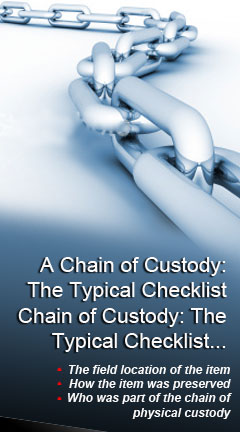Archival Notice
This is an archive page that is no longer being updated. It may contain outdated information and links may no longer function as originally intended.
Home | Glossary | Resources | Help | Course Map
Documenting the chain of custody literally requires each person who touches an item of evidence to sign for its possession. Generically, the term refers to the ability to track tangible evidence items. A typical chain of custody checklist might include the following items:
- The field location of the item. The geographical location where the item was found or observed, including a careful log entry and, if necessary, a photograph of the location.
- How the item was preserved. Evidence items must be bagged, packaged or otherwise handled in such a fashion that the evidentiary value is not destroyed. Appropriate containers should bear complete ID tags and labels.
- Who was part of the chain of physical custody. Each person who handles the item should make a log entry and receipt of the fact that they handled the evidence. As the item passes from person to person, ultimately to a laboratory or storage area, a chain of receipts should be created. No question should ever exist at trial or a hearing that concerns missing items, mishandling or contamination of items, mislabeling of items, destruction of items (other than in special circumstances where destructive tests are required), or breaks in the chain of custody that might jeopardize evidence admissibility.
For more on destructive testing, including steps to follow, see Report Writing and Supporting Documentation, Retaining Samples for Future Testing.
Additional Online Courses
- What Every First Responding Officer Should Know About DNA Evidence
- Collecting DNA Evidence at Property Crime Scenes
- DNA – A Prosecutor’s Practice Notebook
- Crime Scene and DNA Basics
- Laboratory Safety Programs
- DNA Amplification
- Population Genetics and Statistics
- Non-STR DNA Markers: SNPs, Y-STRs, LCN and mtDNA
- Firearms Examiner Training
- Forensic DNA Education for Law Enforcement Decisionmakers
- What Every Investigator and Evidence Technician Should Know About DNA Evidence
- Principles of Forensic DNA for Officers of the Court
- Law 101: Legal Guide for the Forensic Expert
- Laboratory Orientation and Testing of Body Fluids and Tissues
- DNA Extraction and Quantitation
- STR Data Analysis and Interpretation
- Communication Skills, Report Writing, and Courtroom Testimony
- Español for Law Enforcement
- Amplified DNA Product Separation for Forensic Analysts


